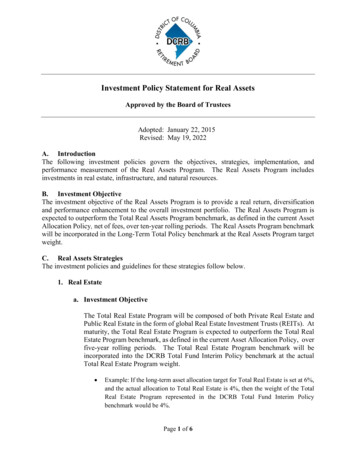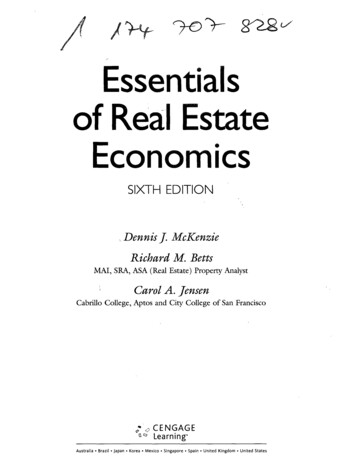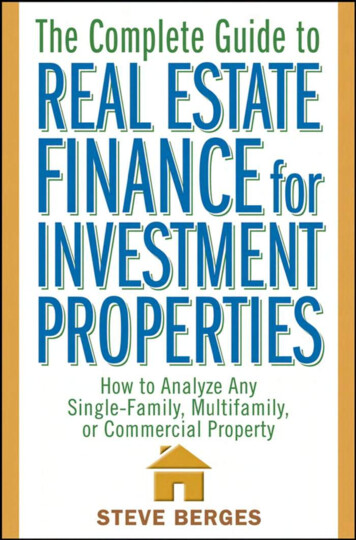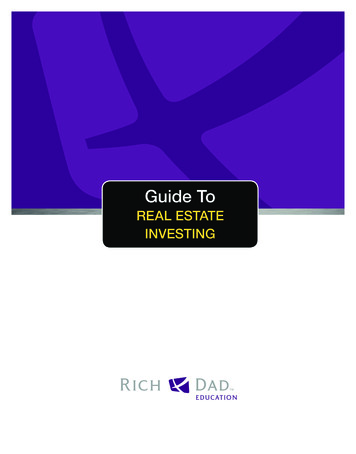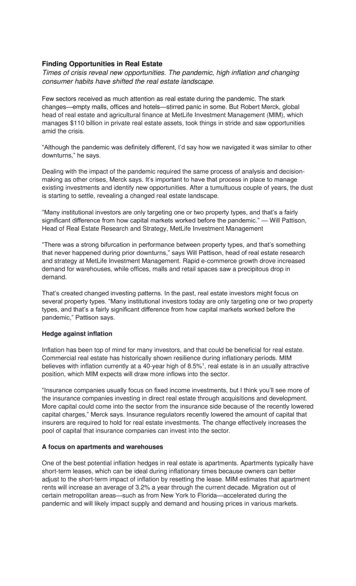
Transcription
Finding Opportunities in Real EstateTimes of crisis reveal new opportunities. The pandemic, high inflation and changingconsumer habits have shifted the real estate landscape.Few sectors received as much attention as real estate during the pandemic. The starkchanges—empty malls, offices and hotels—stirred panic in some. But Robert Merck, globalhead of real estate and agricultural finance at MetLife Investment Management (MIM), whichmanages 110 billion in private real estate assets, took things in stride and saw opportunitiesamid the crisis.“Although the pandemic was definitely different, I’d say how we navigated it was similar to otherdownturns,” he says.Dealing with the impact of the pandemic required the same process of analysis and decisionmaking as other crises, Merck says. It’s important to have that process in place to manageexisting investments and identify new opportunities. After a tumultuous couple of years, the dustis starting to settle, revealing a changed real estate landscape.“Many institutional investors are only targeting one or two property types, and that’s a fairlysignificant difference from how capital markets worked before the pandemic.” — Will Pattison,Head of Real Estate Research and Strategy, MetLife Investment Management“There was a strong bifurcation in performance between property types, and that’s somethingthat never happened during prior downturns,” says Will Pattison, head of real estate researchand strategy at MetLife Investment Management. Rapid e-commerce growth drove increaseddemand for warehouses, while offices, malls and retail spaces saw a precipitous drop indemand.That’s created changed investing patterns. In the past, real estate investors might focus onseveral property types. “Many institutional investors today are only targeting one or two propertytypes, and that’s a fairly significant difference from how capital markets worked before thepandemic,” Pattison says.Hedge against inflationInflation has been top of mind for many investors, and that could be beneficial for real estate.Commercial real estate has historically shown resilience during inflationary periods. MIMbelieves with inflation currently at a 40-year high of 8.5%1, real estate is in an usually attractiveposition, which MIM expects will draw more inflows into the sector.“Insurance companies usually focus on fixed income investments, but I think you’ll see more ofthe insurance companies investing in direct real estate through acquisitions and development.More capital could come into the sector from the insurance side because of the recently loweredcapital charges,” Merck says. Insurance regulators recently lowered the amount of capital thatinsurers are required to hold for real estate investments. The change effectively increases thepool of capital that insurance companies can invest into the sector.A focus on apartments and warehousesOne of the best potential inflation hedges in real estate is apartments. Apartments typically haveshort-term leases, which can be ideal during inflationary times because owners can betteradjust to the short-term impact of inflation by resetting the lease. MIM estimates that apartmentrents will increase an average of 3.2% a year through the current decade. Migration out ofcertain metropolitan areas—such as from New York to Florida—accelerated during thepandemic and will likely impact supply and demand and housing prices in various markets.
MIM Feels another sector to watch is warehouses, which are benefiting from significant ecommerce growth. “I don’t think the market fully understands that online order delivery speedshave been at least as important as the total number of goods being purchased online,” Pattisonsays.A few years ago, order fulfillment might take seven days. Today, it’s closer to one or two days—or even a few hours in some markets. That faster fulfillment means e-commerce companies canno longer rely on a handful of supersized regional warehouses. Instead, there’s a need forsmaller warehouses located in all major cities. These infill warehouses, or last-mile deliverycenters, range from 50,000 to 200,000 square feet, compared to regional or super regionalwarehouses that are often a million square feet.Shifting habits: office space and retailThe abrupt shift to remote work during the pandemic and the increasing popularity of hybridwork led to uncertainty about the future of the office. But Merck says these reports overstate thematter. Remote working has diminished demand in the short term, but MIM does not expectsignificant long-term impact. If anything, the pandemic reversed a long-standing trend towardshrinking square footage per person. Offices are getting bigger, even as fewer people go in.“People want a little bit more space. They don’t want to share space or use hoteling to reserve adesk. I think COVID helped solidify that,” Merck says.Longer term, Merck doesn’t see a significant impact from the growing acceptance of hybridwork. MIM estimates that 9% of the traditional office using employment sectors will become fullyremote, up from about 5% before the pandemic. But lessening demand for office space could bepartially offset by a slowdown in new office construction. As a result, office leases today in mostmarkets are being signed at pre-pandemic prices. While companies with offices in markets suchas New York or San Francisco, which rely heavily on public transit, are more likely to downsizein the near term, MIM believes the impact will be temporary. Not only that, but some of themarkets seeing the worst short-term impact may also see the strongest demand over the nextdecade.Another real estate sector that saw many vacancies in the last two years was retail, whichstruggled even before the pandemic due to e-commerce growth and overbuilding. Thepandemic accelerated the closing of retail centers that likely would have closed anyway. Ofcourse, not all properties are the same. Merck says there’s been a flight to quality, with higherend malls with strong sales per square foot bouncing back. “We’re starting to see that play outin a positive way,” Merck says.In any time of crisis, new opportunities appear. “Real estate has made a really good comeback,both in 2021 and especially this year,” Merck says. The last two years were tumultuous forsome parts of real estate, but buoyed by high inflation and rising consumer demand, we believeoverall the sector’s outlook is bright.1U.S. Bureau of Labor Statistics, May 2022InfographicPulled from MetLife article: Our Outlook and Forecasts for 2022More Capital ExpectedHigh inflation and low interest rates are pushing insurance companies and otherinvestors to direct capital into commercial real estate.
Source: PREA Investment Intentions Survey, January 2022.Based on institutional investors claimer]This material is intended solely for Institutional Investors, Qualified Investors and Professional Investors. Thisanalysis is not intended for distribution with Retail Investors.This document has been prepared by MetLife Investment Management (“MIM”) solely for informational purposesand does not constitute a recommendation regarding any investments or the provision of any investment advice,or constitute or form part of any advertisement of, offer for sale or subscription of, solicitation or invitation of anyoffer or recommendation to purchase or subscribe for any securities or investment advisory services. The viewsexpressed herein are solely those of MIM and do not necessarily reflect, nor are they necessarily consistent with,the views held by, or the forecasts utilized by, the entities within the MetLife enterprise that provide insuranceproducts, annuities and employee benefit programs. The information and opinions presented or contained in thisdocument are provided as of the date it was written. It should be understood that subsequent developments maymaterially affect the information contained in this document, which none of MIM, its affiliates, advisors orrepresentatives are under an obligation to update, revise or affirm. It is not MIM’s intention to provide, and youmay not rely on this document as providing, a recommendation with respect to any particular investment strategyor investment. Affiliates of MIM may perform services for, solicit business from, hold long or short positions in, orotherwise be interested in the investments (including derivatives) of any company mentioned herein. Thisdocument may contain forward-looking statements, as well as predictions, projections and forecasts of theeconomy or economic trends of the markets, which are not necessarily indicative of the future. Any or all forwardlooking statements, as well as those included in any other material discussed at the presentation, may turn out tobe wrong.All investments involve risks including the potential for loss of principle and past performance does not guaranteesimilar future results. Property is a specialist sector that may be less liquid and produce more volatile performancethan an investment in other investment sectors. The value of capital and income will fluctuate as property valuesand rental income rise and fall. The valuation of property is generally a matter of the valuers’ opinion rather thanfact. The amount raised when a property is sold may be less than the valuation. Furthermore, certain investmentsin mortgages, real estate or non-publicly traded securities and private debt instruments have a limited number ofpotential purchasers and sellers. This factor may have the effect of limiting the availability of these investments forpurchase and may also limit the ability to sell such investments at their fair market value in response to changes inthe economy or the financial markets
In the U.S. this document is communicated by MetLife Investment Management, LLC (MIM, LLC), a U.S. SecuritiesExchange Commission registered investment adviser. MIM, LLC is a subsidiary of MetLife, Inc. and part of MetLifeInvestment Management. Registration with the SEC does not imply a certain level of skill or that the SEC hasendorsed the investment advisor.This document is being distributed by MetLife Investment Management Limited (“MIML”), authorised andregulated by the UK Financial Conduct Authority (FCA reference number 623761), registered address Level 34 OneCanada Square London E14 5AA United Kingdom. This document is approved by MIML as a financial promotion fordistribution in the UK. This document is only intended for, and may only be distributed to, investors in the UK andEEA who qualify as a “professional client” as defined under the Markets in Financial Instruments Directive(2014/65/EU), as implemented in the relevant EEA jurisdiction, and the retained EU law version of the same in theUK.MIMEL: For investors in the EEA, this document is being distributed by MetLife Investment Management EuropeLimited (“MIMEL”), authorised and regulated by the Central Bank of Ireland (registered number: C451684),registered address 20 on Hatch, Lower Hatch Street, Dublin 2, Ireland. This document is approved by MIMEL asmarketing communications for the purposes of the EU Directive 2014/65/EU on markets in financial instruments(“MiFID II”). Where MIMEL does not have an applicable cross-border licence, this document is only intended for,and may only be distributed on request to, investors in the EEA who qualify as a “professional client” as definedunder MiFID II, as implemented in the relevant EEA jurisdiction.For investors in the Middle East: This document is directed at and intended for institutional investors (as suchterm is defined in the various jurisdictions) only. The recipient of this document acknowledges that (1) no regulatoror governmental authority in the Gulf Cooperation Council (“GCC”) or the Middle East has reviewed or approvedthis document or the substance contained within it, (2) this document is not for general circulation in the GCC orthe Middle East and is provided on a confidential basis to the addressee only, (3) MetLife Investment Managementis not licensed or regulated by any regulatory or governmental authority in the Middle East or the GCC, and (4) thisdocument does not constitute or form part of any investment advice or solicitation of investment products in theGCC or Middle East or in any jurisdiction in which the provision of investment advice or any solicitation would beunlawful under the securities laws of such jurisdiction (and this document is therefore not construed as such).For investors in Japan: This document is being distributed by MetLife Asset Management Corp. (Japan) (“MAM”),1-3 Kioicho, Chiyoda-ku, Tokyo 102-0094, Tokyo Garden Terrace KioiCho Kioi Tower 25F, a registered FinancialInstruments Business Operator (“FIBO”) under the registration entry Director General of the Kanto Local FinanceBureau (FIBO) No. 2414.For Investors in Hong Kong: This document is being issued by MetLife Investments Asia Limited (“MIAL”), a part ofMIM, and it has not been reviewed by the Securities and Futures Commission of Hong Kong (“SFC”).For investors in Australia: This information is distributed by MIM LLC and is intended for “wholesale clients” asdefined in section 761G of the Corporations Act 2001 (Cth) (the Act). MIM LLC exempt from the requirement tohold an Australian financial services license under the Act in respect of the financial services it provides toAustralian clients. MIM LLC is regulated by the SEC under US law, which is different from Australian law.1MetLife Investment Management (“MIM”) is MetLife, Inc.’s institutional management business and the marketingname for subsidiaries of MetLife that provide investment management services to MetLife’s general account,separate accounts and/or unaffiliated/third party investors, including: Metropolitan Life Insurance Company,MetLife Investment Management, LLC, MetLife Investment Management Limited, MetLife Investments Limited,MetLife Investments Asia Limited, MetLife Latin America Asesorias e Inversiones Limitada, MetLife AssetManagement Corp. (Japan), and MIM I LLC and MetLife Investment Management Europe Limited.L0522022246[exp0524][All States]
head of real estate and agricultural finance at MetLife Investment Management (MIM), which manages 110 billion in private real estate assets, took things in stride and saw opportunities amid the crisis. "Although the pandemic was definitely different, I'd say how we navigated it was similar to other downturns," he says.




